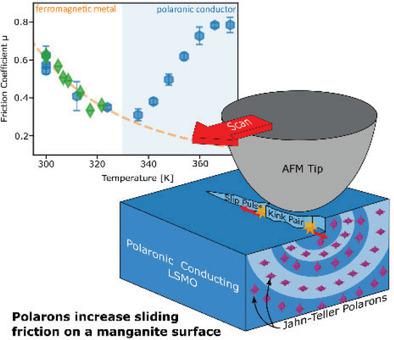Our official English website, www.x-mol.net, welcomes your
feedback! (Note: you will need to create a separate account there.)
Polaronic Contributions to Friction in a Manganite Thin Film
Advanced Science ( IF 14.3 ) Pub Date : 2021-02-18 , DOI: 10.1002/advs.202003524 Niklas A Weber 1 , Hendrik Schmidt 1 , Tim Sievert 1 , Christian Jooss 1, 2 , Friedrich Güthoff 3 , Vasily Moshneaga 4 , Konrad Samwer 2, 4 , Matthias Krüger 5 , Cynthia A Volkert 1, 2
Advanced Science ( IF 14.3 ) Pub Date : 2021-02-18 , DOI: 10.1002/advs.202003524 Niklas A Weber 1 , Hendrik Schmidt 1 , Tim Sievert 1 , Christian Jooss 1, 2 , Friedrich Güthoff 3 , Vasily Moshneaga 4 , Konrad Samwer 2, 4 , Matthias Krüger 5 , Cynthia A Volkert 1, 2
Affiliation

|
Despite the huge importance of friction in regulating movement in all natural and technological processes, the mechanisms underlying dissipation at a sliding contact are still a matter of debate. Attempts to explain the dependence of measured frictional losses at nanoscale contacts on the electronic degrees of freedom of the surrounding materials have so far been controversial. Here, it is proposed that friction can be explained by considering the damping of stick‐slip pulses in a sliding contact. Based on friction force microscopy studies of La(1−x)SrxMnO3 films at the ferromagnetic‐metallic to a paramagnetic‐polaronic conductor phase transition, it is confirmed that the sliding contact generates thermally‐activated slip pulses in the nanoscale contact, and argued that these are damped by direct coupling into the phonon bath. Electron‐phonon coupling leads to the formation of Jahn–Teller polarons and to a clear increase in friction in the high‐temperature phase. There is neither evidence for direct electronic drag on the atomic force microscope tip nor any indication of contributions from electrostatic forces. This intuitive scenario, that friction is governed by the damping of surface vibrational excitations, provides a basis for reconciling controversies in literature studies as well as suggesting possible tactics for controlling friction.
中文翻译:

极化子对锰酸盐薄膜中摩擦的贡献
尽管摩擦对于调节所有自然和技术过程中的运动非常重要,但滑动接触的耗散机制仍然存在争议。迄今为止,试图解释纳米级接触处测量的摩擦损失与周围材料的电子自由度的依赖性一直存在争议。在这里,提出可以通过考虑滑动接触中粘滑脉冲的阻尼来解释摩擦。基于La (1− x ) Sr x MnO 3薄膜在铁磁金属到顺磁极化导体相变时的摩擦力显微镜研究,证实滑动接触在纳米级接触中产生热激活滑移脉冲,并认为这些通过直接耦合到声子浴中而被阻尼。电子声子耦合导致 Jahn-Teller 极化子的形成,并导致高温阶段摩擦力的明显增加。既没有证据表明原子力显微镜尖端有直接的电子阻力,也没有任何迹象表明静电力的贡献。这种直观的情况,即摩擦由表面振动激励的阻尼控制,为调和文献研究中的争议以及提出控制摩擦的可能策略提供了基础。
更新日期:2021-04-22
中文翻译:

极化子对锰酸盐薄膜中摩擦的贡献
尽管摩擦对于调节所有自然和技术过程中的运动非常重要,但滑动接触的耗散机制仍然存在争议。迄今为止,试图解释纳米级接触处测量的摩擦损失与周围材料的电子自由度的依赖性一直存在争议。在这里,提出可以通过考虑滑动接触中粘滑脉冲的阻尼来解释摩擦。基于La (1− x ) Sr x MnO 3薄膜在铁磁金属到顺磁极化导体相变时的摩擦力显微镜研究,证实滑动接触在纳米级接触中产生热激活滑移脉冲,并认为这些通过直接耦合到声子浴中而被阻尼。电子声子耦合导致 Jahn-Teller 极化子的形成,并导致高温阶段摩擦力的明显增加。既没有证据表明原子力显微镜尖端有直接的电子阻力,也没有任何迹象表明静电力的贡献。这种直观的情况,即摩擦由表面振动激励的阻尼控制,为调和文献研究中的争议以及提出控制摩擦的可能策略提供了基础。











































 京公网安备 11010802027423号
京公网安备 11010802027423号